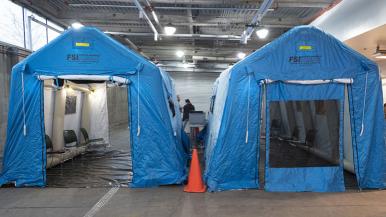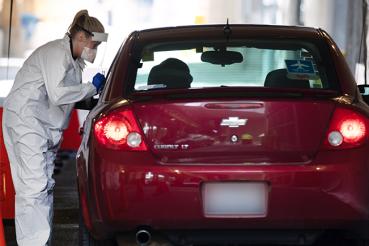Rush University Medical Center is officially operating in surge mode, as preparations for a potential sharp increase in patients with COVID-19 move into a new phase.
As of March 12, Rush has moved from preparedness planning to actionable ability to leverage its expertise and uniquely designed facilities to accommodate a potentially significant surge event where a large number of patients could soon arrive.
“We have been preparing for this every day for weeks,” said Dr. Omar Lateef, CEO of Rush University Medical Center. “We have been exercising our response in real time, as more and more ‘patients under investigation’ reach out in person and virtually, concerned that they have contracted COVID-19. Our modeling indicates that we may well see a significant uptick in patients who may have contracted novel coronavirus.”
Recognized by Vizient and the Centers for Medicare and Medicaid Services as one of the best and safest hospitals in the country, Rush has demonstrated its commitment to patient safety, public health and the ability to treat the most complex cases in medicine.
The activation of the surge plan is in line with Rush’s overall preparedness to deal with infectious disease, while able to treat those with other ambulatory needs without co-mingling patients.
When Rush University Medical Center opened its hospital Tower in 2012, it was the first Chicago area hospital specifically designed to provide treatment for an outbreak of an infectious disease, such as novel coronavirus disease, or COVID-19. Because of this unique approach to design, construction and staff, Rush has become a critical community resource in the fight against such threats to public health.
The butterfly-shaped bed tower was built to perform specific functions, which are especially important during an outbreak like this. For example:
- The Rush Tower has 40 negative pressure rooms, among the highest in Chicago. These assets are critical because it means that when the door to the room opens air from the hall moves into the room, not from the room to the hall. This helps contain any infectious particles in the air in that room.
- The Rush Emergency Department is divided into three 20-bed units — each of which can be isolated with separate air handling. Every ED bed is in its own room with a door, not a curtain, that further isolates each and every patient.
- The Emergency Department has an entry bay for ambulances that is covered and can be arrayed to further isolate infected patients who are entering for evaluation and treatment.
- The Emergency Department can be rapidly converted to enable high-volume screening. Phase 1 of the preparedness plan has already been implemented, with rapid triage and screening of potential coronavirus patients in ambulance bays. It can expand to increase throughput to see an additional 100 patients a day (in addition to their usual volume).
- We are ready to initiate the next phase of plan — in two hours, we can convert a wing of hospital into a negative pressure ward to accommodate more patients. This will increase our isolation room capacity by 32, bringing total capacity to 72 beds, which can all be used for COVID-19 patient treatment. We anticipate needing this for patient care in the next week.
As the Medical Center continues to prepare for a sharp increase in patients with COVID-19, that capability is about to be put to use for the first time.
“The Rush University System for Health is a regional and national resource of emergency preparedness,” Lateef said. “We have prepared for extraordinary events that may put our community at risk. We have created unique facilities and have a specially trained staff to address these kinds of outbreaks. While no system is perfect, we believe that for the novel coronavirus global pandemic, we can provide great care for our patients while also providing for an environment that reduces risk as much as possible for both our patients and the members of our health care team.”
From the outset of its design, part of the hospital Tower was intended for use in a large-scale emergency. Known as the Robert R. McCormick Foundation Center for Advanced Emergency Response, it occupies the hospital’s first floor.
“After 9/11, we knew there may be a need for a specialized treatment area for large-scale emergencies. We more than doubled the size of our emergency department in response to potential natural and manmade disasters and have the capacity to increase our beds substantially with a biocontainment unit,” said Dr. Dino Rumoro, chairperson of Rush’s Department of Emergency Medicine and acting dean of Rush Medical College.
Prepared for a patient surge
This week, Rush made changes to the emergency department that include a “forward (preliminary) triage.” This triage is being performed in a tent that’s been raised over the Emergency Department’s ambulance bay, creating an area for testing potential COVID-19 patients in isolation from general ED patients.
The forward triage area includes seating for possible patients, with each seat placed six feet away to ensure there is no cross contamination of patients. The area also includes a controlled entry point with a separate route into the hospital and negative airflow – all to ensure non coronavirus related patients never come into to contact with a COVID-19 patient or any related contamination.
These capabilities have become vitally important as the Medical Center’s implementation of its COVID-19 patient surge plan becomes imminent. A surge plan is used when a hospital’s patient volume has reached the point of over-capacity, requiring the hospital to use a unique process to manage the heightened number of patients.
As a part of this plan, Rush system clinics may begin to postpone all nonessential appointments and surgeries, depending on the number of possible COVID-19 patients seeking care and the needs of the hospital.
Rush has been collaborating with city, state and federal authorities to detect and coordinate the region’s response to epidemics and crises of every sort. With capacity to handle a sudden influx of patients, decontamination space and surge capabilities, Rush plays a primary role in safeguarding the region’s well-being.
Digital platforms offer virtual triage and options for concerned patients
In the last several years, Rush has developed a robust digital platform. Fully integrated with Epic, the electronic medical record system, a robust telemedicine platform has been deployed.
In the last week we began to provide access to care for worried well, non-acute potential COVID-19 infected patients, employees, and chronically ill non-acute patients to avoid health care setting exposure, looking for medical assessment.
Additionally, Rush researchers developed the Guardian program, a real-time tracking of regional Influenza like illness. With funding from the Department of Defense, Guardian uses EMR data to provide surveillance of the symptoms consistent with COVID-19.
The current novel coronavirus situation has led to the development of a forecasting model that Rush and others are using to estimate regional COVID-19 case volumes. Created through the Center for Quality, Safety, and Value Analytics, the Guardian models and updates with regional case counts and can estimate specific supply estimates and personnel needs. This can help health care organizations of all kinds understand where potential shortages of critical supplies could emerge.
“While COVID-19 and other infectious disease threats are deeply troubling and create tremendous anxiety, it is important to consider that all such new threats are ‘novel’ at first,” said Lateef. “It is organizations like Rush University Medical Center and others who not only take them seriously — preparing and drilling to mitigate risks as rapidly as possible — that are best equipped to serve as a community resource and help shape the response to protect public health. It is what we do.”




